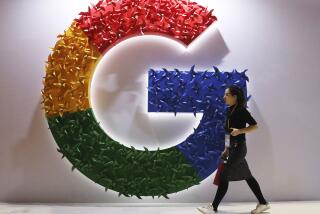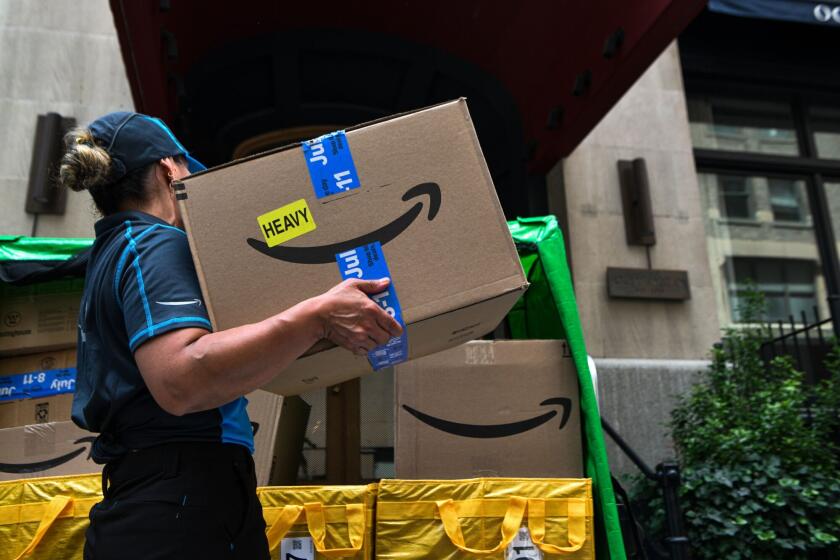Ad trends send Web portals looking far, wide
- Share via
new york -- The recent rush by major Internet portals to buy advertising companies and extend their sales networks is a sign that the business of being a one-stop shop for information and entertainment isn’t what it used to be.
Gone are the days of emphasizing strategies to attract and keep visitors -- the way television networks long have operated -- by creating destinations with anything people might need for work, leisure or companionship.
Instead, those companies are now more aggressively trying to follow Web surfers elsewhere -- and bring lucrative advertising to them.
With people increasingly turning to blogs, social networking sites and other sources of user-generated media, Google Inc., Yahoo Inc., Microsoft Corp. and Time Warner Inc.’s AOL have spent more than $10 billion collectively this year to acquire companies and technologies that help extend their online ad networks.
So instead of relying solely on being portals for consumers, the major companies are creating one-stop shops for advertisers, who increasingly want to buy ads centrally and place them where the eyeballs are. The networks take care of feeding the ads to smaller sites.
“We’re not interested in building yesterday’s portal,” said Ron Grant, AOL’s president and chief operating officer. “Consumers are finding what they are looking for is coming from more and more fragmented places. We need a way for advertisers to take advantage of that fragmentation.”
Such efforts will help enable the major Internet businesses to grab a substantial share of the marketing dollars expected to flow at the expense of television and print.
For consumers, the development means greater freedom and a further erosion of artificial walls designed to keep visitors from leaving sites.
According to ComScore Media Metrix, the U.S. audience for the four major Internet brands grew over the last year. But the total time spent at Yahoo and AOL dropped about 10%, while Microsoft’s MSN-Windows Live services saw an 8% decline.
In other words, these sites are attracting more people but are keeping them for shorter periods as users find what they need elsewhere.
Google was the exception, with a 57% jump in time spent, but even it recognizes that “no individual property will have all those products and services” a user might want, said Tim Armstrong, Google’s head of North American ad sales.
“The Internet is basically being built and scaling [faster] than any one property on the Internet is,” Armstrong said. “Companies in the Internet space are changing their business models to have models which are consumer driven, not property driven.”
That’s not to say the major Internet destinations are ceding their own properties.
In a few cases, the large companies have bought wildly popular sites. Google spent about $1.76 billion in November to absorb the leading video-sharing site, YouTube. It also owns the blogging service Blogger, while Yahoo has photo-sharing site Flickr.
They are also innovating. AOL revamped its video search site in August, while Yahoo retooled its core search engine this month to try to make it more engaging and lure back those who had defected to Google.
“Everyone still wants to be your home page. They are always going to battle for that,” said Nick Nyhan, chief executive of market research firm Dynamic Logic. “But they have to think beyond that. Consumers aren’t going to just take your stuff.”
Google, Yahoo and AOL still make most of their ad money from sites they own and operate (Microsoft did not break down figures in its regulatory filings). Ad networks set the stage for the future and help large Internet companies ensure they will have enough inventory to sell in the years ahead.
Ford Motor Co. can, for instance, come to Google and buy ads that run not only there but also at the New York Times’ website and thousands of others within Google’s AdSense network.
Ford wouldn’t have to deal with all those sites individually; third-party sites wouldn’t have to expand their sales teams.
Meanwhile, Google gets a cut of ad revenue -- without spending a dime developing those specialty sites.
Although this concept isn’t new, what is changing is the scale.
In agreeing to acquire DoubleClick Inc. for $3.1 billion, Google is looking for better ways to deliver multimedia display ads to supplement the small, text-based ads the company already does well.
The pending acquisition also extends Google’s reach beyond AdSense to all the outside sites for which DoubleClick now distributes advertising.
Likewise, in buying Tacoda Inc., AOL not only gets Tacoda’s technology for targeting ads, but also extends its reach to NBC Universal, Scripps Networks and the New York Times (sites can join multiple ad networks). AOL also has a network through its 2004 acquisition of Advertising.com and separately bought companies this year serving international markets and wireless devices.
Yahoo, meanwhile, paid about $650 million for the 80% of Right Media Inc. it did not already own and agreed to buy BlueLithium Inc. for $300 million. Microsoft bought AQuantive Inc. for $6 billion.
“It’s not that networks are going to supplant these mass-market sites, but they will have less influence as networks have more,” said David Hallerman, a senior analyst at research group EMarketer, which projects U.S. online advertising spending at $44 billion in 2011, more than double the $17 billion directed to the Web last year.






